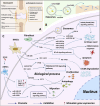Exosomes in cartilage microenvironment regulation and cartilage repair
- PMID: 40109360
- PMCID: PMC11919854
- DOI: 10.3389/fcell.2025.1460416
Exosomes in cartilage microenvironment regulation and cartilage repair
Abstract
Osteoarthritis (OA) is a debilitating disease that predominantly impacts the hip, hand, and knee joints. Its pathology is defined by the progressive degradation of articular cartilage, formation of bone spurs, and synovial inflammation, resulting in pain, joint function limitations, and substantial societal and familial burdens. Current treatment strategies primarily target pain alleviation, yet improved interventions addressing the underlying disease pathology are scarce. Recently, exosomes have emerged as a subject of growing interest in OA therapy. Numerous studies have investigated exosomes to offer promising therapeutic approaches for OA through diverse in vivo and in vitro models, elucidating the mechanisms by which exosomes from various cell sources modulate the cartilage microenvironment and promote cartilage repair. Preclinical investigations have demonstrated the regulatory effects of exosomes originating from human cells, including mesenchymal stem cells (MSC), synovial fibroblasts, chondrocytes, macrophages, and exosomes derived from Chinese herbal medicines, on the modulation of the cartilage microenvironment and cartilage repair through diverse signaling pathways. Additionally, therapeutic mechanisms encompass cartilage inflammation, degradation of the cartilage matrix, proliferation and migration of chondrocytes, autophagy, apoptosis, and mitigation of oxidative stress. An increasing number of exosome carrier scaffolds are under development. Our review adopts a multidimensional approach to enhance comprehension of the pivotal therapeutic functions exerted by exosomes sourced from diverse cell types in OA. Ultimately, our aim is to pinpoint therapeutic targets capable of regulating the cartilage microenvironment and facilitating cartilage repair in OA.
Keywords: cartilage microenvironment; cartilage repair; exosomes; mechanism of action; osteoarthritis.
Copyright © 2025 Longfei, Wenyuan, Weihua, Peng, Sun, Kun, Mincong, Fan, Wei and Qiushi.
Conflict of interest statement
The authors declare that the research was conducted in the absence of any commercial or financial relationships that could be construed as a potential conflict of interest.
Figures



Similar articles
-
Bone marrow mesenchymal stem cell-derived exosomes protect cartilage damage and relieve knee osteoarthritis pain in a rat model of osteoarthritis.Stem Cell Res Ther. 2020 Jul 10;11(1):276. doi: 10.1186/s13287-020-01781-w. Stem Cell Res Ther. 2020. PMID: 32650828 Free PMC article.
-
miR-100-5p-abundant exosomes derived from infrapatellar fat pad MSCs protect articular cartilage and ameliorate gait abnormalities via inhibition of mTOR in osteoarthritis.Biomaterials. 2019 Jun;206:87-100. doi: 10.1016/j.biomaterials.2019.03.022. Epub 2019 Mar 20. Biomaterials. 2019. PMID: 30927715
-
The dual character of exosomes in osteoarthritis: Antagonists and therapeutic agents.Acta Biomater. 2020 Mar 15;105:15-25. doi: 10.1016/j.actbio.2020.01.040. Epub 2020 Feb 6. Acta Biomater. 2020. PMID: 32006653 Review.
-
Remodeling the Proinflammatory Microenvironment in Osteoarthritis through Interleukin-1 Beta Tailored Exosome Cargo for Inflammatory Regulation and Cartilage Regeneration.ACS Nano. 2025 Feb 4;19(4):4924-4941. doi: 10.1021/acsnano.4c16785. Epub 2025 Jan 23. ACS Nano. 2025. PMID: 39848926
-
Harnessing knee joint resident mesenchymal stem cells in cartilage tissue engineering.Acta Biomater. 2023 Sep 15;168:372-387. doi: 10.1016/j.actbio.2023.07.024. Epub 2023 Jul 21. Acta Biomater. 2023. PMID: 37481194 Review.
Cited by
-
Research progress on mesenchymal stem cell‑derived exosomes in the treatment of osteoporosis induced by knee osteoarthritis (Review).Int J Mol Med. 2025 Oct;56(4):160. doi: 10.3892/ijmm.2025.5601. Epub 2025 Aug 1. Int J Mol Med. 2025. PMID: 40747674 Free PMC article. Review.
References
Publication types
LinkOut - more resources
Full Text Sources

